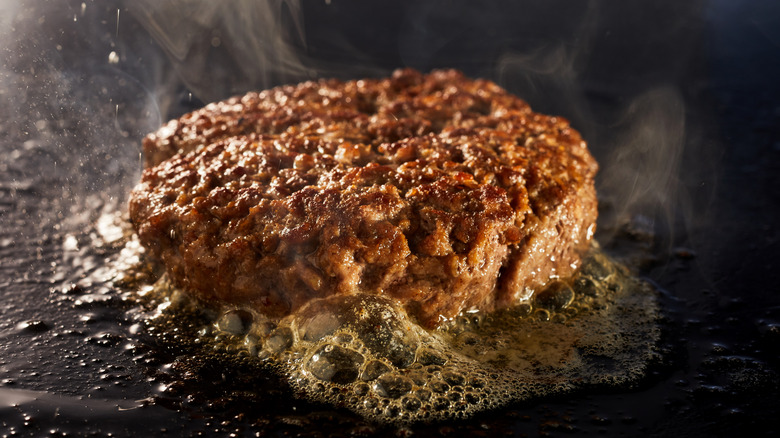Alton Brown's Ironic Method For Non-Greasy Burgers
Alton Brown has an ironic method for making a better, non-greasy burger that is going to blow your mind. Most of us break out the cast iron skillet or turn to the grill to make this classic backyard sandwich, and if you make it on the stovetop, you would probably never even consider adding oil to a pan. The beef is greasy enough. However, Brown encourages burger lovers to use a Dutch oven filled with two inches of heated oil to achieve the fried burger of their dreams. He states on his website, "...this will be the most un-greasy burger you've ever enjoyed."
The "Good Eats" host and cookbook author explains that the Dutch oven needs to be large and you can use either shortening or oil, but you are going to have to turn up the heat to get the temperature of the oil to read 320 degrees Fahrenheit. Once you do, you can cook up to three patties at a time, but don't allow the temperature to drop below 300 degrees Fahrenheit, and here's why.
A good crust means less oil
When you cook your burger in the right amount of oil at the right temperature, the output of heat from the hot oil is going to fry your meat while simultaneously drying the surface of the beef. This is what creates that crispy crust we know and love. But surprisingly, this process only encourages a small amount of oil to cling to that beloved burger crust, producing a patty that is anything but oozing with oil. That said, if you want minimal oil to be soaked up by your disk of meat, you have to keep the heat no lower than Brown's suggested 300 degrees Fahrenheit or you will end up with a greasy mess.
Why is your burger not dripping in grease as the crust forms? The crust you are creating in frying the meat minimizes the pores of a hamburger's surface. When there aren't a lot of pores, there is nowhere for the oil to go. There's some real science behind Brown's thinking and temperature is key. My German Table explains that when a food is fried at 340 degrees Fahrenheit for at least three minutes, it will take on more oil than if you cooked the same ingredient at 310 degrees Fahrenheit. This is because at the lower frying temperature, you lose fewer juices and there is no room for the oil to be absorbed.

